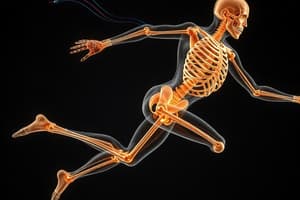Podcast
Questions and Answers
What type of force causes twisting in an object?
What type of force causes twisting in an object?
- Tension
- Compression
- Shear
- Torsion (correct)
Which injury typically results from a blunt object force?
Which injury typically results from a blunt object force?
- Contusion (correct)
- Strain
- Laceration
- Abrasion
What type of force causes sliding and displacement in an object?
What type of force causes sliding and displacement in an object?
- Tension
- Torsion
- Compression
- Shear (correct)
Which tissue injury results from a tear in the skin with rough edges?
Which tissue injury results from a tear in the skin with rough edges?
What does strain refer to in the context of muscle or tendon injuries?
What does strain refer to in the context of muscle or tendon injuries?
Which type of force can lead to inflammation due to repeated micro trauma?
Which type of force can lead to inflammation due to repeated micro trauma?
What type of injury involves a partial dislocation of a joint?
What type of injury involves a partial dislocation of a joint?
Which grade of hamstring strain involves a complete tear of the muscle?
Which grade of hamstring strain involves a complete tear of the muscle?
What type of fracture results from large forces over a large area?
What type of fracture results from large forces over a large area?
Which mechanism causes a spiral fracture due to torsional loading on a bone?
Which mechanism causes a spiral fracture due to torsional loading on a bone?
In the Injury Control Process, what is the second step after establishing the extent of the injury?
In the Injury Control Process, what is the second step after establishing the extent of the injury?
Flashcards are hidden until you start studying
Study Notes
Aetiology and Biomechanics
- Aetiology is the study of causation or origination
- Stress is the load or cross-sectional area of the tissue
- Strain is the amount of deformation, which can be caused by different force directions:
- Compression: force along the axial plane (top to bottom)
- Tension: pulling forces along the axis
- Shear: force is applied parallel in the object, causing sliding and displacement
- Torsion: causes twisting, typically one end is fixed and the other is moving
- Bending: atypical loading pattern, load is different on one side to the other
Types of Tissue Injuries
- Abrasion: skin tissue injury, usually the result of a shear force (e.g., scrap against concrete)
- Contusion: injury to underlying tissue, usually a bruise on the muscle, typically resulting from a force from a blunt object
- Laceration: cut or tear in the skin having rough edges, caused by forces from a sharp and/or hard object
- Strain: an elongation of muscle or tendon beyond the elastic limit, where actual tearing or breaking of some fibers is present, caused by excessive tensile force
- Puncture: small break in the skin from a pointed object, force that is perpendicular to the skin and focused on a small area
- Sprain: stretching and tearing of ligaments or capsular tissue, caused by tensile, shear, or rotary force that pushes the tissue fibers beyond the elastic region
- Inflammation: irritation or swelling causing pain and additional friction, usually a repeated micro-trauma due to tensile strain for muscles and tendons
- Fracture: disruption to the normal matrix of bone tissue, caused by shear, compression, torsional, or tensile forces, or a combination of them
- Subluxation: partial dislocation, injury to a joint which forces it to move beyond its normal limit of motion, usually due to a tensile or compressive force, with some shear to torsional force
- Dislocation: more severe injury where articulating bones have lost their alignment, force may be tensile or compressive and usually involves some shear or torsional loading
Injury Grading
- Hamstring Strain:
- Grade 1: simple pull/elongation of the muscle
- Grade 2: partial tear
- Grade 3: avulsion/complete tear
- Lateral Ankle Sprain:
- Grade 1: stretching, small tears
- Grade 2: larger but incomplete tear
- Grade 3: complete tear
Fracture Types
- Impact Force Fractures (Direct):
- Forces from outside the body
- Transverse fractures: these occur at a slight angle, caused by a tapping mechanism, small forces over a small area
- Crushing mechanism: large forces over a large area, results in an extensive comminuted fracture
- Active Force Fractures (Indirect):
- Due to active forces originating within the body
- Traction mechanism: transverse or avulsion fracture as a result of tensile loading
- Bending mechanism: bending occurring of the bone causing either an oblique or butterfly fracture
- Rotational mechanism: occurs due to torsional loading causing a spiral fracture
- Transverse and oblique fracture: combo of loading patterns causing axial compression and angulation
- Angulation with torsion and axial loading causing a compound fracture
Injury Control Process
-
- Establish the extent of the incidence and severity
-
- Establish the aetiology and mechanisms of the injury
-
- Introduce a preventative measure
-
- Assess its effectiveness by repeating Step 1
Injury Reporting Scale
- Level 1: niggles/pain
- Level 2: modifications in class
- Level 3: off class < 3 days
- Level 4: off class > 3 days
Studying That Suits You
Use AI to generate personalized quizzes and flashcards to suit your learning preferences.




